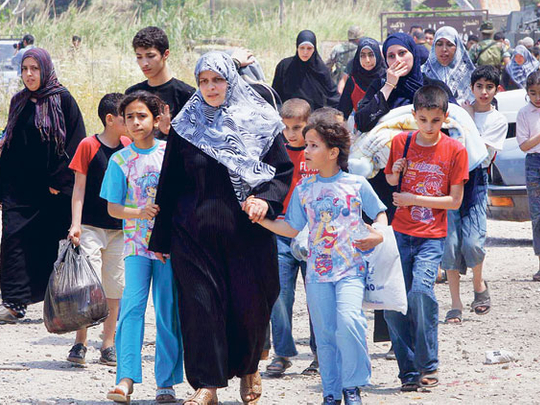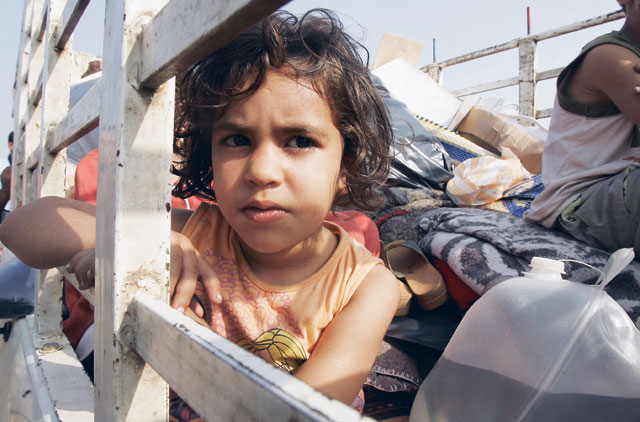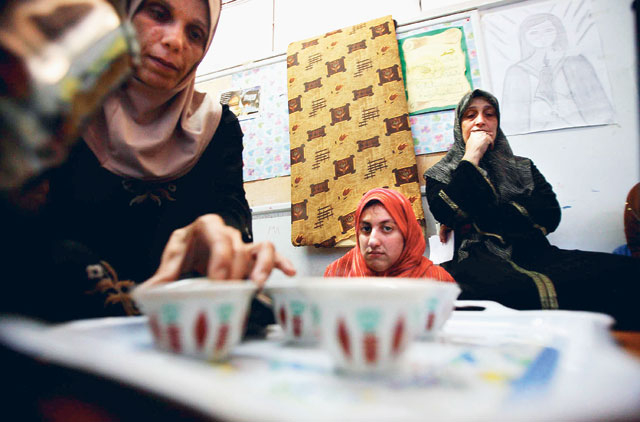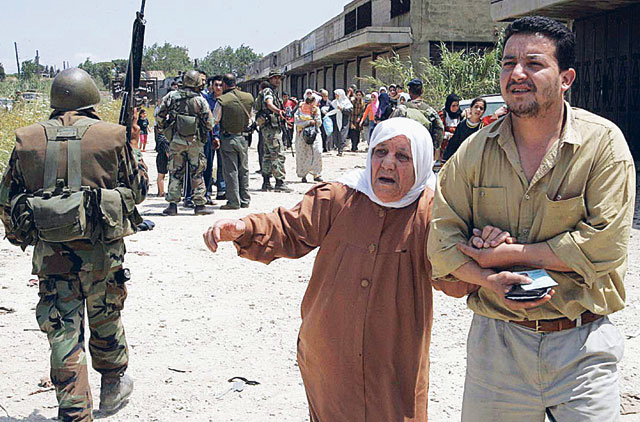
Palestinian refugees in Lebanon, who constitute 10 per cent of the total refugees registered with the United Nations Relief and Works Agency for Palestine Refugees in the Near East (UNRWA) and approximately 11 per cent of Lebanon's total population, continue to live in miserable conditions.
According to statistics released by the international relief agency on March 31, 2003, the total number of refugees registered in Lebanon is 390,498, out of which 220,052 are living in camps and 170,446 outside them.
Though these figures were issued by UNRWA, they are not accurate because they are based on information presented by refugees voluntarily to benefit from the agency's services, to which they are entitled.
These figures do not include the natural increases, as there are Palestinian refugees living within the UNRWA's area of operations but are not registered with it while some of the registered refugees live beyond the area of operation. Besides, there are people who are considered genuine refugees because they were driven out of their home country after the 1948 war but have not registered with the UNRWA.
There was also another wave of Palestinian refugees from Jordan and Egypt in the early 1970s after Jordan's war against the Palestinian Liberation Organisation which led to the banishment of Palestinian resistance fighters to Lebanon.
More than half of the refugees live in 13 camps run by the UN agency, including Nahr Al Bared, which was destroyed during Lebanese army operations in 2007 and has not yet been rebuilt.
The other camps are Baddawi, Burj Al Barajneh, Dhabya, Mar Elias, Ein Al Helweh, Burj Al Shamali, Al Bass, Rashidiya, Shatila, Galil and Mieh-Mieh.
The rest of the refugees live in towns and villages in new community developments across Lebanon.
Among the most important of the groupings not recognised by the UNRWA are Al Mashouq, Jebel Al Bahr, Shabriha, Al Qasimiya, Al Burghuliya, Al Wastsa, Al Etaniya, Abu Al Aswad, Adloun, Al Ghaziya, Al Naemeh, Saad Nael and Thalabiya, among others.
The UNRWA was officially supervising 16 camps, three of which were destroyed during the civil war and have not been rebuilt. They are Nabatieh in the south of Lebanon, Tel Al Zaatar, which saw one of the ugliest massacres by Christian Lebanese Right-wing militias, led by the Kataeb (Phalange) Party, and the camp of Jisr Al Basha in Beirut. There is also a fourth camp called Jaroud in Baalbek, whose inhabitants were evicted and transferred to Rashidiya Camp in Tyre.
On the socio-economic level, new amendments and provisions were introduced in 1995 to the Lebanese law of 1964 regulating the employment of foreigners, imposing more restrictions on foreigners with the aim of protecting the interests of the Lebanese population.
Under the amended law, the non-Lebanese have been barred from practising more than 70 listed professions and have to obtain a work permit from the Ministry of Labour and Social Affairs to take up any profession.
The exceptional conditions of Palestinian refugees were not taken into account when passing the amended law. In fact, the Palestinian refugees do not have a state of their own and hence the principle of reciprocity cannot be implemented. So these refugees found themselves, after more than 50 years of exile, forced to compete in the labour market with other expatriates who do not need prior approval in accordance with the principle of reciprocity applied with their countries.
It is enough to give one example to illustrate the magnitude of the employment problem of the Palestinians: Between 1992 and 2000, Palestinians accounted for only 500 of the 50,000 licences granted to foreigners in the same period.
UNRWA statistics show that 60 per cent of Palestinian refugees in Lebanon are living below the poverty line while 36 per cent do not have any source of income.
Property ownership law
On March 21, 2000, the Lebanese parliament approved amendments to the real estate ownership law. Under the amended law, Article 296 stipulates that "no one is allowed to own a property of any kind if he does not hold the citizenship of a recognised state, or any person if the property ownership is in contradiction to the provisions of the constitution with regard to the rejection of naturalisation".
Under this law, Palestinians have been forbidden from owning property in Lebanon and those who have property cannot transfer it to their heirs. Accordingly, they are also banned from building or even rebuilding their damaged homes in destroyed camps, such as Jisr Al Basha, Tel Al Zaatar and Nabatieh.
This law has had severe consequences for many Palestinian families. Some feel the objective is the forced displacement of Palestinians from Lebanon.
Motives and considerations
Observers believe there are a number of motives that have prompted the Lebanese authorities to take such measures against the Palestinian refugees.
The political structure in Lebanon is based on a sectarian quota between Christians and Muslims. Christians fear that the resettlement and naturalisation of about 400,000 Palestinian refugees, mostly Sunni Muslims, will lead to a strengthening of the Muslim majority, with a resultant push for changing the political system in favour of numerical democracy.
Some Lebanese hold Palestinian refugees responsible for the 1975-1991 civil war, which was enough for the politicians to create an atmosphere of suspicion against Palestinians.
The Lebanese politicians found nothing wrong with fuelling hostilities against Palestinians and reminding their citizens of the dangerous implications of the potential naturalisation of the Palestinians, citing painful memories of the civil war.
Adherence to the principle of the right to return and rejection of the naturalisation of Palestinians
Lebanese officials have been criticised for the tragic situation of the Palestinian refugees, which is worse than that of refugees in Syria and Jordan. These officials justify measures and procedures adopted against the Palestinians in Lebanon, claiming that their actions are in line with the Lebanese constitution and UN resolution No 194 on the right of Palestinians to return.
Hussam Kanafani and Thaer Ghandour are journalists based in Beirut.
List of organisations having presence in Palestinian camps
There are groups in Palestinian camps that may not exist within Palestine itself because many Arab countries created their own groups to use them in the Lebanese civil war and also sought to create divisions within some of these organisations. hese forces can be divided into three general groups:
Palestine Liberation Organisation (PLO). It includes:
- Fatah: A major Palestinian political party and the PLO's largest faction, headed by Palestinian President Mahmoud Abbas. In Lebanon, Fatah is represented by Fat'hi Abu Al Ardat, a member of the Revolutionary Council.
- Popular Front for the Liberation of Palestine (PFLP): Its present secretary-general is Ahmad Sa'adat, who has been in an Israeli jail since 2002. In Lebanon, the PFLP is represented by Marwan Abdul Aal, while Gassan Shamali is its representative in Sidon and the nearby camps.
- Democratic Front for the Liberation of Palestine (DFLP): Its secretary-general is Nayef Hawatmeh. The DFLP is represented by Ali Faisal in Lebanon and Khalid Younus "Abu Ehab" in Sidon and the nearby camps.
- The Palestine Liberation Front (PLF): Its secretary-general is Dr Yousuf Wasel and his deputy is Nazem Al Yousuf. In Lebanon, the PLF is represented by Salah Yousuf and Abu Wael Klaib in Sidon and the nearby camps.
- Palestinian People's Party (PPP): This group is spearheaded by a general secretariat. The PPP is represented by Gassan Ayoub in Lebanon and Omar Al Naddaf in Sidon.
- Popular Struggle Front (PSF): This group is headed by Samir Ghosheh. Tamer Aziz is its chief in Lebanon and Essam Huleihel in Sidon and the nearby camps.
- Arab Liberation Front (ALF): Its secretary-general is Rakkad Salem. It is representated by Samir Sununu in Lebanon and by Abu Yousuf Al Shawaf in Sidon and the nearby camps.
- Palestinian Arab Front (PAF): Its secretary-general is Jameel Shehadeh, aka Abu Khalid Al Arabi, while its representative in Lebanon is Abu Emmad Al Haj.
- Feda Party: Formerly headed by Yasser Abed Rabbo, this group's present secretary-general is Saleh Ra'afat, who split from the DFLP. Its representatives are Ali Al Safadi in Lebanon and Mustafa Murad in the south.
The Damascus-based Alliance of Palestinian Forces (APF):
The APF includes eight Palestinian groups whose key leaders are based in Damascus. At present, these organisations are out of the PLO. Some of these have a strong and active presence in the Occupied Territories and some others have limited presence in refugee camps abroad, especially in Syria and Lebanon. These include:
- Hamas: This is the most powerful of the organisations and rules Gaza. Khalid Mesha'al is the group's political bureau chief, while Ali Baraka is its representative in Lebanon. Abu Ahmad Fadl is the representative in Sidon.
- Islamic Jihad: Its secretary-general is Ramadan Salah, while its representatives are Emmad Al Rifai in Lebanon and Shakib Al Aina in Sidon.
- The Palestine Liberation Front (PLF)-Taalat Yaqoub: Its secretary-general is Yousuf Maqdah, aka Abu Nidal Al Ashkar. Its representative are Mohammad Yassin in Lebanon and Walid Juma in Sidon.
- Fatah Al Intifada Movement, split from Fatah: Its secretary-general is Colonel Abu Mousa. Nimr Qadoura is its representative in Lebanon and Raef Mawed in Sidon.
- Vanguards of the People's Liberation War "Al Saiqa": Its secretary-general is Essam Qadi. Its chief in Lebanon is Abu Hassan Gazi. Ameen Kawash heads the group in the south of the country while Abu Ahmad Afifi is in charge in Sidon.
- Popular Front for the Liberation of Palestine-General Command (PFLP-GC): Its secretary-general is Ahmad Jibril and its chief in Lebanon is Mustafa Ramez (Abu Emmad). It is represented in Sidon by Abu Ali Ahmad.
- Palestinian Popular Struggle Front. Its secretary-general is Khalid Abdul Majid and its chief in Lebanon is Abu Khalid Al Shamal. Abu Hassan Kurdiya represents the group in Sidon.
Islamic forces include those not operating under the PLO or the APF. Notable among these are:
- Osbat Al Ansar is an Islamist Palestinian organisation founded by Shaikh Hesham Shreidi. Its former emir Ahmad Abdul Karim Al Sa'adi "Abu Muhjin" disappeared from public life. The present emir is Shaikh Abu Obaida Mustafa, while his deputy is Shaikh Abu Tarek Al Sa'adi. Its media officer is Shaikh Abu Sharif Aql.
- Ansar Allah is overseen by Jamal Sulaiman and its representative in Sidon is Maher Owaid.
- Islamic Mujahid Movement supervised by Shaikh Jamal Khattab, imam of Al Nour Mosque.
- Jund Al Sham, founded by Shaikh Abu Yousuf Sharqiya on June 28, 2004, was dissolved a year later.
- Islamic Liberation Party, a political party that has no military activities, has presence in some Palestinian refugee camps under the leadership of Ali Aslan.
- Association of Islamic Charitable Projects is headed by Shaikh Hussam Qaraqirah. Shaikh Ursan Eisa is its representative in the camps.
Palestinian camps run by the UNRWA
Ein Al Helweh
Established in 1948, this is the largest of Lebanon's 12 refugee camps and home to 45,337 Palestinians. It is located south of Sidon, about three kilometres from the heart of the city and 45 kilometres south of Beirut. In 2000, the 420-acre camp was home to 70,000 people.
Like other camps in Lebanon, Ein Al Helweh suffers from the lack of basic services, not to mention the "camp wars" that swept refugee camps in Lebanon. Ein Al Helweh is called "the capital of the diaspora" and is politically symbolic.
Rashidiya
About 15 kilometres east of Tyre and 8 kilometres south of Beirut, this camp was established in 1948 over an area of about 267.2 acres. According to 2003 statistics, it had a population of 25,580.
Burj Al Barajneh
Established in 1948 on 104 acres, this camp is considered one of the largest in Beirut. It is located on the main road leading to Beirut International Airport. Like other camps, misery and poverty can be seen in every corner of its muddy streets, which are packed with people.
Many families who live in the camp were expelled from Tarshiha in northern Palestine and constitute 40 per cent of the camp's population, which was 20,405 in 2003.
This camp is overcrowded, with an average of 13 people living in a room measuring 4x4 metres. It is beset by outbreaks of diseases such as tuberculosis, diarrhoea and scabies. The camp was besieged by Amal Movement forces in 1985 and people survived by eating grass, leaves, cats and dogs.
Burj Al Shamali
Established in 1955 over 136 acres, this camp located 5 kilometres east of Tyre is home to 20,000 Palestinians.
Sabra and Shatila
These camps were set up along the western coast of Beirut in 1949 near the Kuwaiti embassy. They cover an area of 39.6 acres. In 1982 the Lebanese Christian Phalange militia carried out a massacre in Sabra and Shatila, which lasted three days and during which 3,000 refugees, mostly women, were slaughtered. The Zionist army lit up the camp with projector lamps and flares to help the militia carry out the killings. According to 2003 statistics, the total number of refugees living in the two camps and registered with UNRWA is 12,235 people.
Baddawi
This is the second camp in the northern city of Tripoli. It was established in 1956 over 200 acres and has a population of 18,000. Many families have migrated to Germany, Denmark and Sweden.
Al Bass
This camp was set up close to Tyre in 1949 on an area of 80 acres. It saw an increase in population, which reached 10,607 in 2003.
Galilee (Wavell)
Located on the outskirts of Baalbek, this camp was established in 1949, covering 43.44 acres. The population stood at 7,553 in 2003.
Mar Elias
Situated in the heart of Beirut, Mar Elias was established in 1952 on 54 acres and has a population of about 7,000 Palestinian Christians. This refugee camp is located near the sports stadium in Beirut and was more secure than Burj Al Barajneh as it fell under the area controlled by the Druze.
Mieh Mieh
Located east of Sidon on a hill just five kilometres from the city, it was built in 1948 on 54 acres and is home to 5,037 people, according to 2003 figures. In 1982, half the camp was demolished by Lebanese Forces militia and 3,000 inhabitants were moved to nearby camps.
Dhabia
This camp was established in Beirut in 1956 on 13.6 acres and had a population of 4,211 in 2003.
Nahr Al Bared
It is the second largest of Lebanon's refugee camps after Ein Al Helweh. Located 15 kilometres north of Tripoli, Nahr Al Bared was established in 1949 on 198.13 acres. In the summer of 2007, when the Lebanese army launched a 100-day assault against the Islamist group Fatah Al Islam, the camp came under continuous bombardment. The fighting displaced the camp's population of 35,000 and destroyed up to 80 per cent of the camp's infrastructure and homes.






